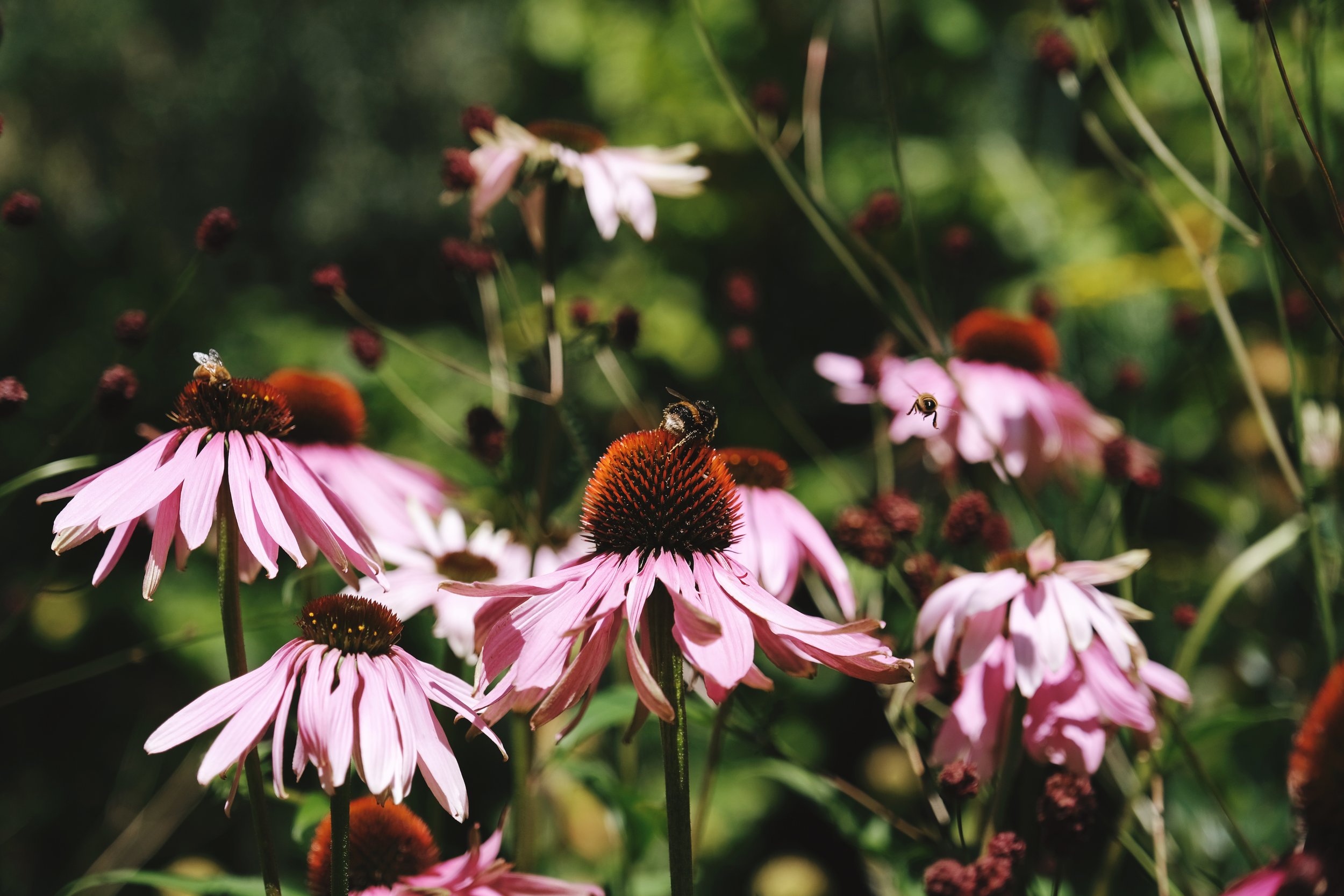Excellent Echinacea
/A riot of echinacea varieties mixed in other airy plants like Sanguisorba officinalis, Verbena bonariensis and veronica.
As my summer garden finishes its warm-up for the full-blown February chorus to come, I’ve been relishing this season’s decision to move my entire collection of echinacea specimens into the same bed.
Previous to my fall into gardening five years ago, echinacea exclusively existed in my world as a go-to cold repellent in tablet form. I honestly wouldn’t have been able to tell you what its flower looked like or even if it had one!
As with all new knowledge gained in my discovery of gardening, my real introduction arrived while trawling for inspiration from beautiful planting via Instagram, magazines and books. I was struck by its graphic, bold form and immediately set off to find out how I could take it beyond my medicine cabinet and into my little garden.
For a beginner gardener, growing echinacea couldn’t be more gratifying. The mainstream varieties purchased from garden centres are extremely uncomplicated in their needs and inspire new growers with their beautiful, long-lasting flowers.
Purchased plants can be popped into the ground at any point over the summer and into autumn, and I find there are often discounted treasures to be discovered in the end-of-season sales. For the new gardener transplanting bought plants at the end of the season, don’t be dismayed when they appear to “die” and disappear from sight as the weather cools. This is simply their normal behaviour as a perennial, and you can rest assured they will show new growth in spring.
Echinacea ‘Sombrero Salsa Red’ mixed in with phlomis and eryngium amongst others.
Echinacea is also good to grow from seed, and it is best practice to sow and raise undercover 8-10 weeks before planting out seedlings, ideally in early summer.
As a sun-loving prairie plant, echinacea is more tolerant of dry spells than others, and I’ve noticed that it still performs well in my dappled shade areas. It actually thrives with a little neglect!
Plants in their second season and beyond feature bolstered clumps and an increased crop of blooms, which attract a lot of attention from pollinators. Being herbaceous perennials, you can dig up and divide these in autumn or spring to increase your plant stock in the years to come.
Picking and deadheading over the season will encourage the plant to keep producing flowers into autumn. The intriguing cone shape of their seed heads are lovely to leave to mature on the plant despite the petals having dropped off. They provide a welcome nibble for birds and offer the chance of some soft self-seeding. In spring, I readily prick out these new seedlings to plant elsewhere in the garden.
Alternatively, to test if seed heads are ready to be harvested for saving, gently run your thumb over the top. It is ready to be snipped off and stowed if the seeds easily come away from the centre of the cone.
In winter, you can then cut the remaining, wilting plant to the ground where it will tuck itself up for bed, ready to go again a few months later.
My favourite way to integrate echinacea into my overall garden-scape is by sticking with the taller growing varieties and interplanting them with other airy plants like sanguisorba, veronica and Verbena bonariensis. Their bold flower heads atop long straight stems give the impression that they are floating in midair between their neighbours. The great spectrum of colour and variety within the species offers many colourways and petal shape to explore for creative results.
Echinacea purpurea is a favourite for pollinators
My own collection began with the classic pink petaled Echinacea purpurea, whose amber cone and starry shape really can’t be beaten. The word echinacea is derived from the Greek meaning “‘spiny one” in reference to sea urchins. Purpurea means “reddish-purple” and refers to the classic lipstick tones of the common ray-shaped petals.
You will find many slightly different varieties under this species, with one of my favourites being bold “Magnus”, which sports a huge plump cone and flat fan of pink petals.
Echinacea ‘Alba’
From my first experiments, I have explored further into echinacea territory. I adore the white-petaled varieties like shorter growing “Baby Swan White” and scopey “Alba”.
I am undecided on my love/hate for the pink and green variegated petals of “Giant Lime”, or more commonly found, “Green Twister”, and would love to get my hands on the wild fluffy, double-petaled “Doubledecker”.
Echinacea ‘Giant Lime’ ….this exact one I haven’t spotted again but very similar is ‘Green Twister’.
Echinacea ‘Sombrero Salsa Red’
Echinacea ‘Mango’ among Knautia macedonica, Verbena rigida and fennel.
Most recently, I bundled home “Sombrero Salsa Red” and “Mango” from Southern Woods Nursery. They are both ridiculously saturated, almost neon in colour in their respective tangerine and orange tones, adding electric accents to my planting.
Perhaps one of my favourites is Echinacea pallida “Hula Dancer”, a plant with more delicate features than its cousins and exquisite long, droopy, pale pink petals that are synonymous with the pallida species. Unfortunately, I have found it much harder to establish and haven’t seen its flowers yet this season.
So I would encourage you to dip your toe into the world of echinaceas, even just purchasing a few, readily available dwarf varieties (under 50 cm) that do extremely well in pots.
Echinacea pallida ‘Hula Dancer’
This is an expanded version of the article featured in my Stuff ‘Homed’ gardening column for beginners , The Press, Dominion Post and other regional papers on February 3rd 2022
All words and images are my own, taken in my home and garden in Christchurch, New Zealand unless otherwise captioned.











